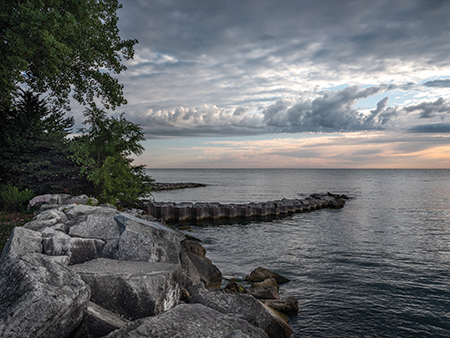
Nancy, who studied and worked in France for 10 years, writes about health, cultural events, food and the healing power of the arts.
Access to water offers mental and physical benefits, however you choose to interact with it
![]() Fact checked by Catherine Gianaro
Fact checked by Catherine Gianaro
The benefits of water run deeper than hydration. Blue space — bodies of water such as the expansive Lake Michigan and meandering Chicago River — benefit human wellness in myriad ways. People who spend time near natural bodies of water reported positive effects on their physical and mental health, according to BlueHealth, a pan-European research initiative focused on urban blue spaces, climate, and health.
Some people know these benefits instinctively. When Chicagoan Nelson Armour, a fine arts photographer, learned in 2019 that he had prostate cancer, he turned to Lake Michigan to cope. He says previous experience sailing had created a personal, unique connection with the lake.

He decided to photograph the lake at sunrise from the same place at Evanston’s South Beach every day during the 28 days of his radiation therapy at Evanston Hospital. “The mood and the color of the lake can change dramatically, sometimes in the same day, from turmoil to calm and peaceful,” he says.
Water’s beauty
The impact that Lake Michigan has on people’s mental well-being begins with something as simple as its color. “The psychology of color tells us that the color blue is very calming and soothing,” says Rene Roberts, MD, a family health specialist at Oak Street Health. “The rhythm of the waves and the ebb and flow of the water are also very soothing,” she adds. “The sights and sounds of the water release neurochemicals from the brain that reduce depression and psychological stress.”
Armour’s experience confirms this. He also says he saw his own experience reflected in the lake. “There was a breakwater that jutted out into the lake that I saw as being symbolic of the cancer,” he says.
Every day he climbed onto rocks, dry or wet, at the same place on the lakeshore and found a stable place to set his camera’s tripod. “The combination of the lake and taking the photos was an emotional marker of each day’s treatment,” he says. “I was living in the moment.”

In 2020, Armour’s photographs of Lake Michigan were displayed at Evanston’s Perspective Gallery in an exhibition called 28 Days, illustrating the benefits he reaped from Lake Michigan during his cancer treatment.
Roberts, who is a member of the American College of Lifestyle Medicine, emphasizes the need for these benefits, especially in urban environments. “We are constantly being bombarded as we make our way through city traffic, and our brains need some downtime from that and also from our digital devices.”
Spending time in the sunlight on the beach brings physiological benefits, too. “The sunshine helps our body make vitamin D, which is very important for bone health because it prevents thinning of the bones [by helping them absorb calcium] that can lead to osteoporosis,” Roberts says.
Still, it’s about finding balance. Roberts says to avoid excessive time directly in the sun during its strongest hours from 10 a.m. to 4 p.m., “and sunscreen is a must for all skin colors.”
When you get outside, walking provides a good workout, improves circulation, and helps maintain a healthy weight. Walking on sandy beaches? Even better.
“Walking in the soft sand acts as a cushion. [It] is better on the joints than walking on hard asphalt and better at improving coordination and balance, which is especially good in preventing older adults from falling,” Roberts says.
Spending time in the water lets swimmers get physically active while basking in blue space.
“We have the advantage of being buoyant in the water,” Roberts says.
“So wading, floating, or swimming are excellent choices for people with arthritis because it takes pressure off of the joints, particularly in the lower back, the hips, and the knees.”
The other blue space
When you think of blue space, don’t forget about rivers. “Lake Michigan and the Chicago River are of equal value,” says Margaret Frisbie, executive director of Friends of the Chicago River. However, she adds, while many people have to travel to the lake, “the river is a blue-green corridor that runs through many neighborhoods in Chicago and the Cook and Lake County Forest Preserves. It’s near where people live, access is easy, and it’s an intimate experience that can be part of their everyday lives.”
“The psychology of color tells us that the color blue is very calming and soothing”
People can get a physical workout by hiking or cycling along the river trail, but the river also offers a refuge from city life.
“The [noise] pollution of urban living is bad for us,” Frisbie says. “The river gives you a chance to unwind because it is a quiet place that slows you down so you’re living at the pace of nature.”
Kayaking or canoeing on the river is an ideal way to reap its physical and mental benefits. “It’s good exercise and a chance to experience coyotes and foxes, mink, muskrats, and beavers, owls, and heron,” Frisbie says. “Going with the flow harkens back to less-developed times; it slows you down so you can be introspective about what you are seeing and about your feelings about yourself.”
No matter how people choose to enjoy the physical and mental benefits of Lake Michigan and the Chicago River, Roberts says she thinks of blue space as “a free prescription” for wellbeing.












